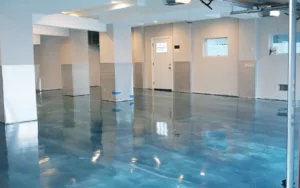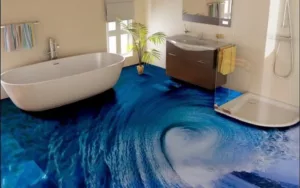All About Epoxy Flooring: Types, Costs, and Appropriate Applications

Peering into the advanced interior and exterior embellishment, one stumble upon epoxy flooring – an amalgamation of technological sophistication, functionality, and artistic brilliance. Epoxy, a union of resin and hardeners, forms a rigid polymer substance that takes on the guise of a plastic material once intermixed and solidified. The resultant compound is resilient to wear, deterioration, and chemical interference. Its robustness, adaptability, and lifespan have catapulted epoxy flooring to widespread recognition in a spectrum of industries, be it in the confines of private residences or sprawling commercial edifices. This exposition ventures into the various sub-categories of epoxy flooring, gauging their cost and identifying suitable environments for each application.
Tip: What are the different flooring material types?
Exposition on Epoxy Flooring Varieties
Epoxy flooring varieties are described below.

Self-Leveling Epoxy Ground Surfaces: Synonymous with a level, unbroken, and smooth texture that covers inconsistencies, self-leveling epoxy flooring can rejuvenate old, worn-out, or structurally compromised concrete floors. Commercial, industrial, and domestic settings make ideal landscapes for this type of flooring. An abundance of color schemes and ornamental designs, including the trending metallic epoxy floors, are available for perusal and selection.
Quartz-Infused Epoxy Ground Surfaces: Epoxy floors suffused with quartz incorporate a robust epoxy polymer resin paired with tinted quartz grains. This fusion results in a pleasing-to-the-eye, multi-purpose, and slip-proof surface that finds its home in spaces demanding clean, long-lasting, and visually appealing flooring solutions. This flooring is frequently seen gracing restrooms, educational institutions, eating areas, reception areas, corporate spaces, and exhibition areas.
Epoxy Mortar Ground Surfaces: As the epitome of epoxy flooring toughness, epoxy mortar floors are concocted using pure epoxies paired with graded or quartz sand. These floors are the go-to choice for heavy industry and commercial kitchen environments, offering a floor that can withstand intense chemical and physical impacts.
Epoxy Flake Ground Surfaces: Epoxy flake floors employ colored flake materials that are introduced into the epoxy, leading to a lively, multi-colored, and textured surface. This variant offers a slip-resistant surface and finds wide usage in commercial and residential applications, encompassing garages, exhibition spaces, commercial food preparation areas, and sports centers.
Financial Implications of Epoxy Flooring
The choice of epoxy significantly influences the financial burden of epoxy flooring, the current state of the floor, and the total area requiring coverage.
- Self-Leveling Epoxy Floors: This variant can set you back anywhere between $3 and $7 per square foot, contingent on the job’s complexity and the epoxy’s quality.
- Quartz-Infused Epoxy Floors: This superior type will likely incur a cost ranging from $7 to $10 per square foot, given the high-grade materials and intensive labor required.
- Epoxy Mortar Floors: These floors come with a price tag between $5 and $10 per square foot owing to the robust materials and laborious work,
- Epoxy Flake Floors: Depending on the extent of flake inclusion and the intricacy of the job, these floors can cost anywhere from $3 to $6 per square foot.

See More: Which one is better, American or Brazilian Cherrywood flooring?
Ideal Implementations of Epoxy Flooring
Identifying the most fitting epoxy flooring depends on usage objectives, budgetary allocations, and aesthetic inclination.
- Self-Leveling Epoxy Floors: They find their niche in environments demanding a seamless, low-maintenance surface, such as storage facilities, food preparation areas, and manufacturing units.
- Quartz-Infused Epoxy Floors: They are the optimal choice for high-footfall areas needing an aesthetic uplift, such as educational facilities, food serving areas, and corporate structures.
- Epoxy Mortar Floors: They are the ideal candidates for areas subject to intense physical activity or chemical exposure, such as vehicle storage areas, manufacturing establishments, and processing units.
- Epoxy Flake Floors: They are well-suited for areas that need a decorative and slip-proof surface, like commercial kitchens, changing rooms, sports establishments, and car display areas.
Sequences for Epoxy Flooring Installation
Immaculate and expert installation is a must to guarantee the enduring functionality and effectiveness of epoxy flooring. The process typically commences with a meticulous evaluation of the existing floor state. Following this is the crucial step of surface preparation, which involves rigorous cleaning, repairing defects, and grinding the surface. Subsequently, a primer is layered onto the surface, setting the stage for the epoxy mixture. This step necessitates an adequate curing period. Lastly, a protective topcoat is applied to enhance the floor’s lifespan. The expertise and diligence of professional installers are paramount to guarantee that the epoxy flooring performs optimally for many years.
Epoxy Flooring Upkeep
Epoxy floors are lauded for their minimal maintenance requirements, a feature that has played a considerable role in their widespread adoption. Routine sweeping paired with occasional mopping is typically adequate for daily care. Spills should be rapidly addressed to avert staining or damage. For stubborn stains, gentle, non-abrasive cleaning agents are recommended. Consistent upkeep can prolong life and maintain the visual appeal of the epoxy floor, underscoring the significance of habitual care.
Ecological Considerations of Epoxy Flooring
From an environmental perspective, epoxy flooring stands out due to its exceptional durability, which negates the need for frequent replacements and ensuing waste. Some epoxy formulations have little to zero volatile organic compounds (VOCs), thus curbing harmful emissions during installation. Further, epoxy floors’ extended lifespan and ease of cleaning foster a healthier indoor ambiance.
Innovative Advances in Epoxy Flooring
The trajectory of epoxy flooring evolution has welcomed several cutting-edge variations. One such innovation is photoluminescent epoxy floors that can glow in the darkness, offering a distinct aesthetic appeal and promoting safety during power outages. Other advancements include anti-microbial epoxy flooring that curbs the proliferation of bacteria and other microbes, which proves invaluable in healthcare facilities. The inherent versatility and adaptability of epoxy pave the way for unending opportunities for innovation within this industry.

Epoxy Flooring and Its Artistic Connotations
Beyond its transformative impact on commercial and residential spaces, epoxy flooring has made significant inroads into art. Epoxy’s capability to blend with colorants and create mesmerizing visual effects has endeared it to contemporary artists.
Artistic epoxy floors, frequently seen adorning galleries, museums, and artist residences, infuse an extra dimension of originality and creativity into these spaces. This transformation elevates floors from mere functional entities to standalone works of art. This flooring style is distinguished by its vibrant colors, sparkly effects, and abstract motifs, achieved through skilled manipulation of epoxy mixtures. Metallic finishes, three-dimensional illusions, or breath-taking imitations of natural phenomena such as undulating rivers or molten lava are common features of an artistic epoxy floor.
Technology-Enhanced Epoxy Flooring
Technological progress is expected to create more opportunities for innovative enhancements in epoxy flooring. One promising development area is smart flooring, where epoxy could be adapted to incorporate sensors and other electronic components, allowing floors to interact with users or track data about their use, offering an entirely new dimension of functionality.
Eco-Friendly Epoxy Solutions
As sustainability continues to rise in importance across all sectors, the flooring industry will not be an exception. The demand for environmentally friendly flooring solutions will likely grow, and epoxy flooring could be at the forefront of this change. Companies may innovate to produce more eco-friendly epoxy solutions, using recyclable materials or renewable sources and minimizing harmful byproducts.
Epoxy Flooring Cost
Every gallon of epoxy flooring covers almost 80 to 200 square feet, but it depends on how thick your layers are. Normally epoxy floorings are about 1 or 2 centimeters thick. As for epoxy flooring cost, it depends on various elements, mostly the type of flooring. Epoxies come in 3 different types: water-based, solvent, and solid and their key difference is about their longevity. Keep in mind that epoxy and epoxy paint are not the same and epoxy paint is used as a floor coating and is much cheaper. Based on what type you choose epoxy flooring costs can start from $40 and go up to $150.
Conclusion
Epoxy flooring, with its extensive range and sturdy characteristics, has earned its place as an attractive flooring option for diverse settings. Each variant caters to unique needs and budgets, from self-levelling epoxy floors designed for uneven surfaces to quartz-infused epoxy floors perfect for high-traffic areas. The resilience and aesthetic flexibility of epoxy flooring mark it as a significant player in the flooring industry. The choice of suitable epoxy flooring should consider the specific demands of the environment, budgetary provisions, and the aesthetic vision sought.



Did you find what you were looking for?